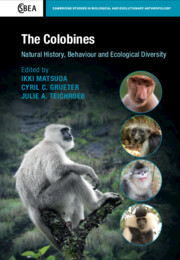Book contents
- The Colobines
- Cambridge Studies in Biological and Evolutionary Anthropology
- The Colobines
- Copyright page
- Contents
- Contributors
- Foreword
- Acknowledgements
- 1 General Introduction
- 2 Taxonomic Classification of Colobine Monkeys
- 3 The Colobine Fossil Record
- 4 Molecular Phylogeny and Phylogeography of Colobines
- 5 Relationships between the Diet and Dentition of Asian Leaf Monkeys
- 6 Morphology and Physiology of Colobine Digestive Tracts
- 7 Colobine Gut Microbiota
- 8 Colobine Nutritional Ecology
- 9 Red Colobus Natural History
- 10 Natural History of Black-and-White Colobus Monkeys
- 11 Behaviour and Ecology of Olive Colobus
- 12 Ecology and Behaviour of Odd-Nosed Colobines
- 13 Ecology of Semnopithecus
- 14 Ecology of Sympatric and Allopatric Presbytis and Trachypithecus Langurs in Sundaland
- 15 Ecology of Trachypithecus spp. in the Indo-Burmese Region
- 16 Socioecology of Asian Colobines
- 17 Socioecology of African Colobines
- 18 Causes and Consequences of the Formation of Multilevel Societies in Colobines
- 19 Colobine Population Ecology
- 20 State of Asian Colobines and Their Conservation Needs
- 21 Conservation of Africa’s Colobine Monkeys (Cercopithecidae, Colobinae) with Taxonomic and Biogeographic Considerations
- 22 Directions for Future Research
- References
- Index
19 - Colobine Population Ecology
What Limits Population Size
Published online by Cambridge University Press: 08 February 2022
- The Colobines
- Cambridge Studies in Biological and Evolutionary Anthropology
- The Colobines
- Copyright page
- Contents
- Contributors
- Foreword
- Acknowledgements
- 1 General Introduction
- 2 Taxonomic Classification of Colobine Monkeys
- 3 The Colobine Fossil Record
- 4 Molecular Phylogeny and Phylogeography of Colobines
- 5 Relationships between the Diet and Dentition of Asian Leaf Monkeys
- 6 Morphology and Physiology of Colobine Digestive Tracts
- 7 Colobine Gut Microbiota
- 8 Colobine Nutritional Ecology
- 9 Red Colobus Natural History
- 10 Natural History of Black-and-White Colobus Monkeys
- 11 Behaviour and Ecology of Olive Colobus
- 12 Ecology and Behaviour of Odd-Nosed Colobines
- 13 Ecology of Semnopithecus
- 14 Ecology of Sympatric and Allopatric Presbytis and Trachypithecus Langurs in Sundaland
- 15 Ecology of Trachypithecus spp. in the Indo-Burmese Region
- 16 Socioecology of Asian Colobines
- 17 Socioecology of African Colobines
- 18 Causes and Consequences of the Formation of Multilevel Societies in Colobines
- 19 Colobine Population Ecology
- 20 State of Asian Colobines and Their Conservation Needs
- 21 Conservation of Africa’s Colobine Monkeys (Cercopithecidae, Colobinae) with Taxonomic and Biogeographic Considerations
- 22 Directions for Future Research
- References
- Index
Summary
Given the destruction that humans are bringing to the natural habitat of colobine monkeys, it is important to understand the factors affecting colobine population dynamics so that effective conservation programs can be planned and put into action. Here we consider the effects of food quality and availability, competition, predation, and disease in determining colobus abundance. We find there is little evidence that natural disasters, predation, or disease play a strong role in regulating colobine numbers, but they can cause dramatic declines in populations at specific points in time and space. Given the difficulty of determining niche overlap and competition, no conclusion can be made regarding the role of interspecific competition in limiting colobine abundance. It seems most likely that colobines are limited by the availability of quality food, but the exact nature of that limitation remains unclear.
Keywords
- Type
- Chapter
- Information
- The ColobinesNatural History, Behaviour and Ecological Diversity, pp. 312 - 323Publisher: Cambridge University PressPrint publication year: 2022

